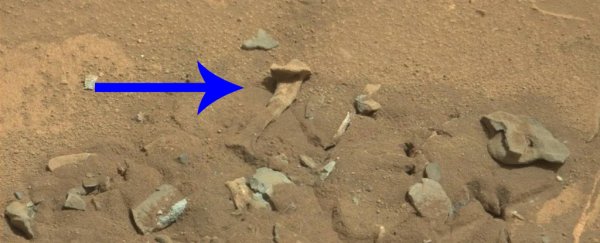A 2014 Mars photo that has strangely resurfaced in tabloids this month does not show a femur amidst the rubble of the Red Planet. Like all such photos to date, the object you see is just a plain old Mars rock. And NASA debunked it six years ago.
The image was taken using the Curiosity Rover's MastCam on 14 August 2014, and rapidly spread among conspiracy theorists as proof Mars once harboured life, prompting the space agency to set the record straight.
"Seen by Mars rover Curiosity using its MastCam, this Mars rock may look like a femur thigh bone. Mission science team members think its shape is likely sculpted by erosion, either wind or water," wrote a NASA spokesperson in a brief blog post.
"If life ever existed on Mars, scientists expect that it would be small simple life forms called microbes. Mars likely never had enough oxygen in its atmosphere and elsewhere to support more complex organisms. Thus, large fossils are not likely."
Seeing patterns in random configurations isn't a new phenomenon. You probably do it every day without realising - whether it's a face in your power outlet or a pawprint in the soap scum on your shower door. This phenomenon is called pareidolia, and it's thought to occur when some parts of the brain process visual information and jump to conclusions before the rest of your brain catches up.
Here on Earth, most people recognise their pareidolia for what it is, but for some reason - perhaps because we can't go there and poke the objects in question - pareidolia on Mars is fertile territory for conspiracy theorists.
Many rocks have sparked flights of fancy about signs of ancient life or even full-blown civilisations on Mars. The most famous, perhaps, was the picture of a region called Cydonia, taken in 1976, thought to show a massive sculpture of a face (later, high-resolution images showed it was… just a rock formation).
There's also the Mars Bigfoot, the Mars cannonball, the Mars spoon, the Mars warrior woman and the Mars "Assyrian god". Last year, a scientist claimed to have identified fossilised insects on Mars. Another claimed to have found mushrooms. But there's absolutely no evidence that these images show anything other than weathered rocks.
We've been sending missions to Mars since the 1960s, including four successful rovers and five successful landers. Scientists are itching to find signs of life - past or present - on that dusty red rock-ball. Not only would it be fascinating to learn what extraterrestrial life looks like, it would be incredible evidence that Earth is not unique in the Universe.
Our efforts are currently focused on microbes. As NASA already noted, the Martian environment is probably not and may have never been conducive to more complex life. If more complex life has thrived on Mars in the past few billion years, our rovers and orbiters have found absolutely no evidence for it.
Whoever makes that first detection is going to go down in history (and be a very strong candidate for a Nobel Prize); scientists have no interest in covering up evidence of life on Mars. This vaguely femur-shaped rock is simply not it.
As for why the image is showing up again in tabloids now, six years after it was discovered and debunked, your guess is as good as ours.
